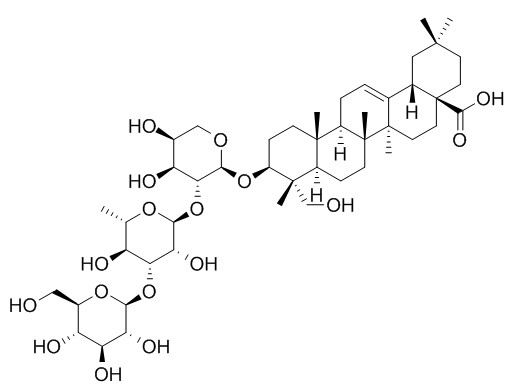Kalopanaxsaponin H
Kalopanaxsaponin H has antidiabetic activity.
Inquire / Order:
manager@chemfaces.com
Technical Inquiries:
service@chemfaces.com
Tel:
+86-27-84237783
Fax:
+86-27-84254680
Address:
1 Building, No. 83, CheCheng Rd., Wuhan Economic and Technological Development Zone, Wuhan, Hubei 430056, PRC
Providing storage is as stated on the product vial and the vial is kept tightly sealed, the product can be stored for up to
24 months(2-8C).
Wherever possible, you should prepare and use solutions on the same day. However, if you need to make up stock solutions in advance, we recommend that you store the solution as aliquots in tightly sealed vials at -20C. Generally, these will be useable for up to two weeks. Before use, and prior to opening the vial we recommend that you allow your product to equilibrate to room temperature for at least 1 hour.
Need more advice on solubility, usage and handling? Please email to: service@chemfaces.com
The packaging of the product may have turned upside down during transportation, resulting in the natural compounds adhering to the neck or cap of the vial. take the vial out of its packaging and gently shake to let the compounds fall to the bottom of the vial. for liquid products, centrifuge at 200-500 RPM to gather the liquid at the bottom of the vial. try to avoid loss or contamination during handling.
Anal Bioanal Chem. 2016, 408(15)
Korean J. of Food Sci. and Tech2016, 172-177
Metabolites.2019, 9(11):E271
Front Plant Sci.2023, 14:1207940.
Kyung Hee University2024, rs-3888374
Molecules.2022, 27(22):7997.
Front Pharmacol.2022, 13:806869.
Cells.2024, 13(14):1229.
Cell Rep.2022, 39(1):110643.
Planta Med.2023, a-2192-2281.
Related and Featured Products
Biol Pharm Bull. 1998 Apr;21(4):360-5.
Metabolism of kalopanaxsaponin B and H by human intestinal bacteria and antidiabetic activity of their metabolites.[Pubmed:
9586573]
To investigate the relationship between the intestinal bacterial metabolism of kalopanaxsaponin B and Kalopanaxsaponin H from Kalopanax pictus (Araliaceae), and their antidiabetic effect, kalopanaxsaponin B and Kalopanaxsaponin H were metabolized by human intestinal microflora and the antidiabetic activity of their metabolites was measured.
METHODS AND RESULTS:
Kalopanaxsaponin H was metabolized to kalopanaxsaponin A and I, hederagenin 3-O-alpha-L-arabinopyranoside and hederagenin. The main metabolites of Kalopanaxsaponin H were kalopanaxsaponin I and hederagenin. Among kalopanaxsaponin B, H and their metabolites, kalopanaxsaponin A showed the most potent antidiabetic activity, followed by hederagenin. However, the main components, kalopanaxsaponin B and Kalopanaxsaponin H, in K. pictus were inactive.
Biol Pharm Bull. 2002 Jan;25(1):68-71.
Metabolism of kalopanaxsaponin K by human intestinal bacteria and antirheumatoid arthritis activity of their metabolites.[Pubmed:
11824560]
METHODS AND RESULTS:
When kalopanaxsaponin K (KPK) from Kalopanax pictus was incubated for 24 h at 37 degrees C with human intestinal microflora, KPK was mainly metabolized to kalopanaxsaponin I (KPI) via Kalopanaxsaponin H (KPH) rather than via kalopanaxsaponin J (KPJ), and then transformed to kalopanaxsaponin A (KPA) and hederagenin. Bacteroides sp., and Bifidobacterium sp. and Fusobacterium sp. transformed KPK to KPI and KPA and hederagenin via Kalopanaxsaponin H or KPJ. However, Lactobacillus sp. and Streptococcus sp. transformed KPK to KPI, KPA, and hederagenin only via KPJ.
CONCLUSIONS:
The metabolite KPA of KPK showed potent antirheumatoid arthritis activity.
Planta Med. 2000 May;66(4):329-32.
Essential moiety for antimutagenic and cytotoxic activity of hederagenin monodesmosides and bisdesmosides isolated from the stem bark of Kalopanax pictus.[Pubmed:
10865448 ]
For the elucidation of the antimutagenic and cytotoxic principles from the stem bark of Kalopanax pictus, seven isolated components of this crude drug were tested in the Ames test and the MTT test.
METHODS AND RESULTS:
Hederagenin and its monodesmosides, kalopanaxsaponin A and kalopanaxsaponin I in addition to its bisdesmosides, kalopanaxsaponin B and Kalopanaxsaponin H, showed potent antimutagenic activities against aflatoxin B1 (AFB1). However, they had no inhibitory effects on mutagenicity induced by the direct mutagen, N-methyl-N'-nitro-N-nitrosoguanidine (MNNG). This suggested that hederagenin glycosides might effectively prevent the metabolic activation of AFB1 or scavenge the electrophilic intermediate capable of inducing mutation. Hederagenin was found to be an essential moiety for the exhibition of antimutagenicity. Moreover, hederagenin and its 3-O-glycosides were found to be cytotoxic on various tumor cell lines, P-388, L-1210, U-937, HL-60, SNU-5 and HepG2, while 3,28-di-O-glycosides of hederagenin were not cytotoxic.
CONCLUSIONS:
Hence, hederagenin and its 3-O-glycosides could be suitable for cancer treatment chemopreventive drugs.



